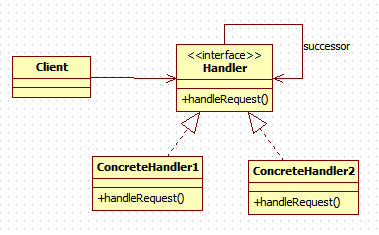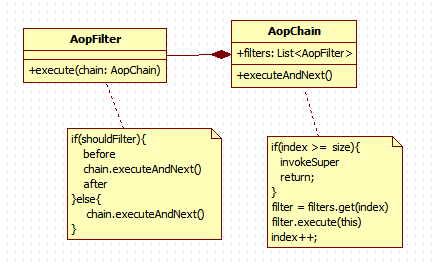【14】行为型-责任链模式
1、上下文及定义
Chain of Responsibility(CoR) 是用一系列类(classes)试图处理一个请求request,这些类之间是一个松散的耦合,唯一共同点是在他们之间传递request. 也就是说,来了一个请求,A类先处理,如果没有处理,就传递到B类处理,如果没有处理,就传递到C类处理,就这样象一个链条(chain)一样传递下去。
2、常用场景
(1)AOP
(2)Servlet filter
3、解决方法
在一个链上,都有相应职责的类,因此叫Chain of Responsibility.
优点:
因为无法预知来自外界(客户端)的请求是属于哪种类型,每个类如果碰到它不能处理的请求只要放弃就可以。
缺点:
(1)效率低,因为一个请求的完成可能要遍历到最后才可能完成,当然也可以用树的概念优化。 在Java AWT1.0中,对于鼠标按键事情的处理就是使用CoR,到Java.1.1以后,就使用Observer代替CoR
(2)扩展性差,因为在CoR中,一定要有一个统一的接口Handler.局限性就在这里。
与Command模式区别:
Command 模式需要事先协商客户端和服务器端的调用关系,比如 1 代表 start ,2 代表 move 等,这些 都是封装在 request 中,到达服务器端再分解。
CoR 模式就无需这种事先约定,服务器端可以使用 CoR 模式进行客户端请求的猜测,一个个猜测 试验。
4、抽象模型
aop chain
5、代码实例
(1)模型实例
handler
public abstract class Handler
{
/**
* @link aggregation
* @supplierCardinality 0..1
*/
protected Handler successor;
public abstract void handleRequest();
public void setSuccessor(Handler successor)
{
this.successor = successor;
}
public Handler getSuccessor()
{
return successor;
}
}
handler实现类
public class ConcreteHandler extends Handler
{
public void handleRequest()
{
if (getSuccessor() != null)
{
System.out.println("The request is passed to " + getSuccessor());
getSuccessor().handleRequest();
}
else
{
System.out.println("The request is handled here.");
}
}
}
客户端
public class Client
{
/**
* @directed
*/
static private Handler handler1, handler2;
public static void main(String[] args)
{
handler1 = new ConcreteHandler();
handler2 = new ConcreteHandler();
handler1.setSuccessor(handler2);
handler1.handleRequest();
}
}
(2)抽象出Request
handler接口
public interface Handler{
public void handleRequest(Request request);
}
request类
public class Request{
private String type;
public Request(String type){this.type=type;}
public String getType(){return type;}
public void execute(){
//request真正具体行为代码
}
}
handler实现
public class ConcreteHandler implements Handler{
private Handler successor;
public ConcreteHandler(Handler successor){
this.successor=successor;
}
public void handleRequest(Request request){
if (request instanceof HelpRequest){
//这里是处理Help的具体代码
}else if (request instanceof PrintRequst){
request.execute();
}else
//传递到下一个
successor.handle(request);
}
}
}
(3)Servlet的Filter Chain
filter实例
/**
* 整个web的编码过滤
* 设定为UTF-8编码
* @author: caibosi
* @created: 2013-10-20
* @time: 15:18:12
*/
//@WebFilter(value="/*",asyncSupported = true)
public class EncodingFilter implements Filter {
@Override
public void init(FilterConfig filterConfig) throws ServletException {
}
@Override
public void doFilter(ServletRequest request, ServletResponse response, FilterChain chain) throws IOException, ServletException {
request.setCharacterEncoding("UTF-8");
chain.doFilter(request, response);
}
@Override
public void destroy() {
}
}
具体看tomcat的ApplicationFilterChain的实现
(4)AOP的Aop Chain
aop chain
/**
* @author caibosi
* @created 2013-10-30
*/
public class AopChain {
/**
* 对一个方法的一系列拦截
*/
private List<AopFilter> aopList;
/**
* 当前拦截的index
*/
private int currentAopIndex = 0;
/**
* 被拦截的类
*/
private Class<?> targetClass;
/**
* 被拦截的对象
*/
private Object targetObject;
/**
* 被拦截的方法
*/
private Method targetMethod;
/**
* 被拦截的方法的参数
*/
private Object[] methodParams;
/**
* 经过拦截处理后的方法
*/
private MethodProxy aoppedMethod;
/**
* 被拦截处理后的对象
*/
private Object aoppedObject;
public AopChain(Class<?> targetClass,Object targetObject,Method targetMethod,
Object[] methodParams,MethodProxy methodProxy,List<AopFilter> aopList){
this.targetClass = targetClass;
this.targetObject = targetObject;
this.targetMethod = targetMethod;
this.aoppedMethod = methodProxy;
this.methodParams = methodParams;
this.aopList = aopList;
}
/**
* 执行当前拦截
* 并挑战到下一个拦截
*/
public void executeAndNext(){
if(currentAopIndex < aopList.size()){
AopFilter aop = aopList.get(currentAopIndex);
//设置下一个拦截
currentAopIndex++;
//执行当前拦截,传入chain,拦截后继续调用chain的executeAndNext
aop.execute(this);
} else{
try {
aoppedObject = aoppedMethod.invokeSuper(targetObject,methodParams);
} catch (Throwable throwable) {
ExceptionTool.transformException(throwable);
}
}
}
public Class<?> getTargetClass() {
return targetClass;
}
public Object getTargetObject() {
return targetObject;
}
public Method getTargetMethod() {
return targetMethod;
}
public Object[] getMethodParams() {
return methodParams;
}
public MethodProxy getAoppedMethod() {
return aoppedMethod;
}
public Object getAoppedObject() {
return aoppedObject;
}
}
aop filter类
/**
* @author: caibosi
* @created: 2013-10-31
*/
public abstract class AopFilter {
//aop的拦截方法
public void execute(AopChain chain) {
Class<?> targetClass = chain.getTargetClass();
Method targetMethod = chain.getTargetMethod();
Object[] params = chain.getMethodParams();
//调用模板,提供钩子方法
begin(targetClass,targetMethod,params);
try{
if(filter(targetClass,targetMethod,params)){
before(targetClass,targetMethod,params);
chain.executeAndNext();
after(targetClass,targetMethod,params);
}else{
chain.executeAndNext();
}
} catch (Exception e){
/**
* 这里catch exception,而不是throwable
* http://www.importnew.com/7383.html
* http://docs.oracle.com/javase/7/docs/api/
*
* error和exception都继承至throwalbe接口
* 而error属于jvm系统的异常,一般无法控制
* Error表示编译时和系统错误,通常不能预期和恢复,比如硬件故障、JVM崩溃、内存不足等
* 因而这里不捕获,而捕获exception
*
* exception又分runtime exception 和checked exception
* checked exception 一般跟外部资源有关(如文件、数据库等)
* 自定义的exception继承至runtime exception
*
* throws用在方法头,用来标记该方法可能没有处理的异常,需要调用者警惕
* throw
*
*/
error(targetClass,targetMethod,params,e);
} finally {
end(targetClass,targetMethod,params);
}
}
//钩子方法,可以延迟到子类实现
public void begin(Class<?> targetClass,Method targetMethod,Object[] params){}
public void end(Class<?> targetClass,Method targetMethod,Object[] params){}
public boolean filter(Class<?> targetClass,Method targetMethod,Object[] params){
return true;
}
public void before(Class<?> targetClass, Method targetMethod, Object[] params) {}
public void after(Class<?> targetClass, Method targetMethod, Object[] params) {}
public void error(Class<?> targetClass, Method targetMethod, Object[] params, Exception e){}
}
aop factory
/**
* @author caibosi
* @created 2013-10-30
*/
public class AopFactory {
public static <T> T getAoppedObject(final Class<?> targetClass,final List<AopFilter> aopList){
return (T) Enhancer.create(targetClass,new MethodInterceptor() {
@Override
public Object intercept(Object target, Method method, Object[] args, MethodProxy methodProxy) throws Throwable {
AopChain aopChain = new AopChain(targetClass,target,method,args,methodProxy,aopList);
aopChain.executeAndNext();
return aopChain.getAoppedObject();
}
});
}
}

